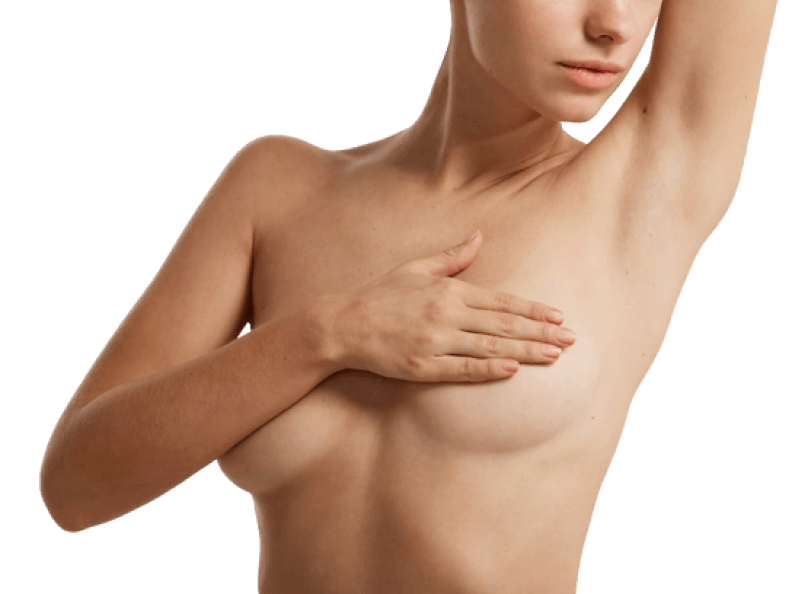Do you want to improve the appearance of your chest?

The weight by itself is not a determining factor to carry out this technique, though it is true that there should be deposits with a sufficient amount of fatty tissue volume to be able to perform the procedure. For example, you could have a good weight but have “love handles” or hips that serve as the donor areas. It should be noted that only a 30-40% of the extracted fat has enough quality to be transplanted.
Fat is obtained with liposuction from other parts of the body. There are no areas that are better or worse. However, the most common areas are the abdomen, the sides and the hips.
It is centrifuged or filtered to extract the viable cells. Broken cells, blood and filtration fluids, etc. are eliminated. We have tu purify it for the fat transfer.Fat cannot be cryopreserved as other tissues.This is why we try to get the fat that we need for the breast enhancement. It is always very wise to leave some fat in the body, in case we need a second session or a touch up. Another optin is to “supercharge” the graft. This means that we get some extra fat, obtain the stem cells from it and we mix up these cells with our fat tissue. By having more stem cells, we ensure better “taking”. This technique is called “cell assisted lipotransfer”.
In only one session you can go up one cup. What we know is that if the procedure is repeated, you can gain more volume, given that the fatty tissue is inserted into an area that already has tissue of the same class. The receptor area accepts the tissue better and there is less re-absorption.
If you wish a fuller appearance or rounder profile of the upper breast and cleavage, you should choose a breast implant instead.
EXCELENTETrustindex verifica que la fuente original de la reseña sea Google. Maravillosa experiencia con la Doctora Salvador!!!Trustindex verifica que la fuente original de la reseña sea Google. Estic encantada! Son els millors!Trustindex verifica que la fuente original de la reseña sea Google. Muy profesionales. El trato es atento y cercano. Los resultados óptimos. He quedado muy satisfecho, los recomiendo totalmente.Trustindex verifica que la fuente original de la reseña sea Google. Es la mejor clínica. Yo fue operado por el Dr. Benito. Durante mucho tiempo elegí una clínica y un médico, dudé. Pero tuve mucha suerte, ¡caí en manos de oro! Estoy muy contenta con el resultado inmejorable. El doctor es un especialista muy atento y elegante. Todo el personal de la clínica es muy agradable. ????????✨????Trustindex verifica que la fuente original de la reseña sea Google. Muy buena clínica, la doctora Salvador explica todo de manera que sabes que estas en buenas manos.Trustindex verifica que la fuente original de la reseña sea Google. Espectacular resultado gracias al dr.benito y a su equipo????Trustindex verifica que la fuente original de la reseña sea Google. Hace más de 15 años que confío en el doctor Jesús Benito. Un gran cirujano y una persona encantadora. Gracias por todos los cuidados !!!!Trustindex verifica que la fuente original de la reseña sea Google. Muy agradecido al Dr Benito por la confianza que se gana y que te ayuda a tomar decisiones. Muy satisfecho con su profesionalidad y los resultados. Y muy contento con su equipo por lo cómodo y fácil que te hacen todo.
He worked at the Hospital Clínic in Barcelona as a specialist in Plastic and Reconstructive Surgery for 16 years.
Fifteen years ago, together with two other professionals, he founded Antiaging Group Barcelona, at the forefront of Aesthetic Medicine and Surgery. He has developed professionally in the field of care, research and teaching, being his fields of interest facial surgery, breast surgery and body contouring with implants.
In breast surgery he is a specialist in transaxillary breast augmentation and secondary breast surgery. He has introduced the use of ultrasound in Plastic Surgery and recently the use of 3D implants in thoracic malformations.
University Specialist in Plastic, Reconstructive and Aesthetic Surgery, having completed his training at the Hospital Clinic in Barcelona.
He has worked in hospitals in the United Kingdom and Zaragoza and is currently part of the Breast Unit of the Plastic Surgery Service of the Hospital de Bellvitge in Barcelona.
The fat tissue is a living tissue. Therefore, the cells act like any other cells in the body. If you lose weight, the cells will decrease in volume and the opposite will happen if you gain weight. The number of cells remains the same. We all know that there are areas that lose more weight than others when we lose weight. For example, there are women that lose facial fat before they lose fat in the breasts. This cannot be predicted.
Possibly. There are differences depending on the body in terms of volume increase according to different areas. Breast augmentation with fat transfer is a natural procedure and we are working with living tissue.
The breast is swollen, but the pain is much less compared to a breast enlargement surgery with implants. What could disturb you more is the donor area from which we harvested the fat.
Yes. The fat becomes part of the structure of the breast and there is no problem if you place an implant later in case you would like to have more volume.
Yes, but you should note that we cannot place fat in the space left by the implant because the cells do not hold the fat. Part of the fat can be transplanted and the rest can be done in the second or even the third time. You should also note that the volume and projection of the breast that we achieve will be less.
There are many teams around the world, including our team, who have been using this technique for years. As with any other surgical procedure, there are complications that we should be aware of. However, the procedure has been improving in a way that it is currently part of the safe techniques we, as plastic surgeons, use.
There is no known relationship between fatty tissue transplant and cancer. If somebody tells you otherwise, they are leading to unfounded fears (or have other interests) What can technically happen is that some fatty cysts or micro-calcifications (microscopic cysts that accumulate calcium) can be produced. They do not have more importance than those related to the interpretation of mammographies, which is why a mammography is always performed before the intervention and another one in a year to determine the changes produced by the intervention. It has been seen that techniques such as breast reduction lead to many more changes in the image of mammography than a transplant of fat in the breasts.
No. In fact, mammography technicians interpret breasts with fatty tissues much better than those with implants. The fat is seen “transparent” in the mammography and is visualised better. A mammography always needs to be performed before the procedure so that the specialists can evaluate the changes.
The breast looks completely natural. Above all, what we can do with fat transplant is change the shape in a way that is not very useful for correcting asymmetric features in the shape of the breast (for example, a tuberous breast). What we do not have with fat transplant is the projection: the fat is distributed throughout the breast as a whole and adds volume, but it does not push. In turn, the prosthesis is inside a “pocket” behind the gland which it pushes forward. This is the main difference between the two techniques in terms of shape.
Up to the day of the publication of this post, around ten years.
Medical Quality







Follow us